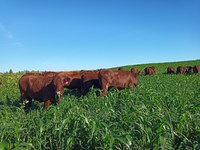Consider annual forages and cover crops when hay production is down
(Click the image below to view a high-resolution image that can be downloaded)
Another challenging year for spring moisture has created a deficit in hay production across much of the Dakotas and Minnesota, leaving ranchers to consider options to increase their forage supply. Lack of rainfall from mid-May to mid-June impacted forage production of perennial grass hay fields such as brome grass, crested wheatgrass, timothy and orchardgrass. State-wide reports have indicated as much as a 40% decline in hay production compared to the previous year.
“Recent precipitation may make annual forages and cover crops viable forage options for hay production or grazing,” says Miranda Meehan, North Dakota State University Extension livestock environmental stewardship specialist.
Despite recent rains, available soil moisture and recommended planting dates will limit options. Forage species selected will vary based on primary planned use: hay, fall grazing, or next spring haying or grazing.
Recommended forage species for hay production
“The best options this late in the growing season will be warm-season forages,” says Kevin Sedivec, NDSU Extension rangeland management specialist. “Foxtail millets have the shortest growing period (seed germination to heading). With droughty conditions, Siberian millet may be the best option; however, under better moisture conditions, German millet could be a better option to maximize production potential. Other options include sudangrass and sorghum-sudangrass hybrids.”
These warm-season crops should be planted by no later than late July or early August. Harvest before a hard frost or directly following the hard frost to retain forage quality and palatability. Sudangrass and the sorghum-sudangrass hybrids have higher yield potential, but because of the shorter day-length and cooler temperatures in late summer and early fall, sufficient dry down to put up hay can be difficult when using a sorghum-sudangrass hybrid. A dry stalk trait is available in some sorghum-sudangrass hybrids that speeds drying time due to stalks containing a lower moisture content.
Recommendation for fall/winter grazing
Many forage options can be planted now and grazed late summer through early winter. Foxtail millet, sudangrass and sorghum-sudangrass can also be used as pasture. However, once they freeze, livestock tend to be more selective and increase waste through trampling. Following a killing freeze, allow sorghum species to completely dry down before grazing to minimize prussic acid potential.
Cool-season cover crop mixtures make excellent pasture well into the early winter period. However, cool-season plants are less efficient at using water and will be more prone to fail if dry conditions persist. Make sure ample topsoil moisture is available for plant establishment.
A good option for a fall and winter grazing mix is a seed mixture with a combination of cool and warm-season crops. The cool-season crops will retain nutritional quality after a freeze while the warm-season crop provides fiber for energy and proper rumen function. Cool-season cover crop options may include a mixture of oats, barley, turnips or radish.
Recommendation for spring grazing or haying in 2024
Winter annuals can be a great option for spring grazing or late spring hay, helping to reduce pressure on already stressed rangeland and pastures while providing cover on the soils. September is the optimal planting date for winter annuals; however, they can be seeded in August if moisture conditions are good. Options include winter wheat, winter rye and winter triticale. Winter annuals can be utilized for early season grazing or harvested for hay in June.
Winter rye and triticale will be the best option for grazing in May through early June. Both winter rye and triticale can be harvested for hay by early June Winter wheat produces less foliage in May and will provide a better option for high quality hay in late June.
When to Purchase Hay
“If you plan to purchase hay to offset a shortage, we recommend sourcing hay early this year,” says James Rogers, NDSU Extension forage crops production specialist.
Severe to extreme drought persists throughout much of the Central Plains states and Corn Belt. Demand for hay is expected to be high in these regions, with producers sourcing hay from the Dakotas and Minnesota. With a depleted hay inventory projected throughout much of the Great Plains, hay prices are likely to increase from their current levels.
Precautions
Many annual forages have toxic risks when growing under stress. Cereal grains, turnips, sorghum species and millet can by high in nitrates when grown in droughty conditions. Do not add any additional nitrogen fertilizers when planting these forage crops this summer. Test for nitrate levels, especially if plant growth occurs under drought stress. Sorghum, sudangrass and sorghum-sudangrass hybrids are susceptible to prussic acid toxicity when immature, under stress or directly after a frost.
“We realize that producers are taking a risk in establishing an annual crop, given the dry conditions, and cost may be a factor,” Meehan says. “NDSU Extension has developed a cover crop cost calculator that provides the ability to estimate and compare the cost of different mixes.”
The tool is available at: tinyurl.com/NDSUCoverCropCalculator
“Farmers may be reluctant to plant annual forages because of fear of soil moisture depletion and desire to recharge the soil,” say Sedivec. “If the cover crop develops enough structure, it will protect the soil from erosion while providing aid in trapping snow and reducing evaporation for moisture conservation, potentially improving soil moisture for spring planting, while providing forage for livestock.”
NDSU Agriculture Communication – July 17, 2023
Source: Miranda Meehan, 701-231-7683, miranda.meehan@ndsu.edu
Source: Kevin Sedivec, 701-424-3606, kevin.sedivec@ndsu.edu
Source: James Rogers, 701-857-7682, james.rogers.1@ndsu.edu
Editor: Elizabeth Cronin, 701-231-7881, elizabeth.cronin@ndsu.edu


